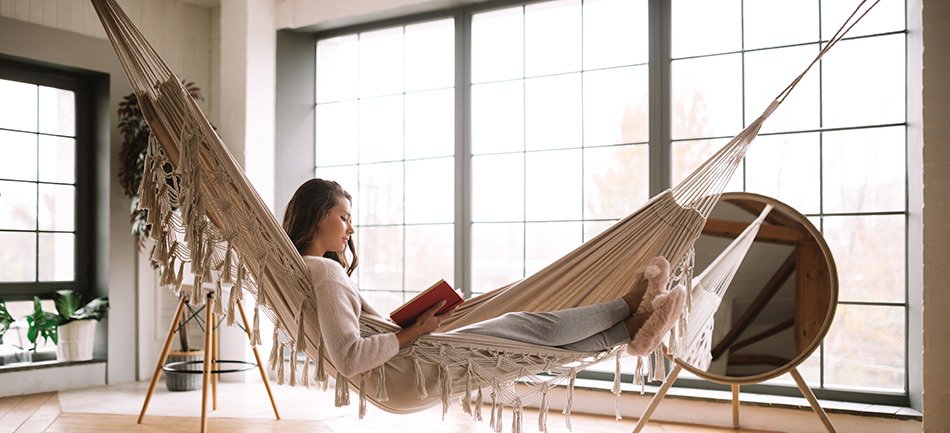Historically, hammocks have been synonymous with outdoor leisure, gently swaying amidst trees in a backyard or by the lakeside. For many hammock enthusiasts, the onset of summer triggers the excitement of embracing their hammocks in an outdoor setting.
Yet, the belief that hammocks are exclusive to the open-air domain is a misconception. These comfortable retreats seamlessly integrate into your indoor living space, promising relaxation year-round, come rain or shine.
The realm of indoor possibilities, from sunrooms to living spaces, even replacing traditional beds, unfolds as you incorporate a hammock. Beyond providing comfort, hammocks present an excellent avenue for unwinding, alleviating the strains on your back. They effectively minimize restlessness and, depending on your chosen style, cocoon you into a profoundly peaceful sleep.
Adding to its appeal is the versatility of anchoring options, allowing you the freedom to set up a hammock in nearly any area of your abode. If measuring and drilling into your walls doesn't resonate with you, a robust stand can be a reliable indoor alternative.
In the subsequent sections, let's delve into picking the perfect hammock for indoor use and how to master the art of hanging the hammock for indoor use.
Picking the Perfect Hammock for Indoor Tranquility
Selecting an ideal hammock from a myriad of options can indeed be a daunting task. To facilitate a well-informed choice, comprehending when and how you intend to use it for your comfort is crucial. A simple hammock suffices for sporadic naps, eschewing the need for extravagance. However, if you envision transforming it into a bed for a restful night's sleep, investing in an extra-comfortable model with springs stands as a prudent decision.
As for the hammock's material, choices encompass cotton, polyester, quilted fabric, and rope. Indoor hammocks showcase a plethora of designs, offering abundant options to align with your preferences.
Prioritizing the security and durability of the hammock rope remains paramount. Cotton hammocks reign in popularity owing to their robustness, plush texture, and ease of maintenance, making them an excellent choice for indoor settings.
Tailoring the hammock's size to fit the available space within your home is imperative. By considering these factors, you can successfully select a hammock that aligns with your needs and preferences, enhancing your indoor relaxation experience. After selecting the hammock, you shouldn't forget to learn how to clean a hammock. This will assist in prolonging its life and will give it a clean indoor sleeping or lounging spot.
Mastering the Technique of Hanging an Indoor Hammock: A Stepwise Guide
Ensuring a secure and proper hanging of your hammock is pivotal to enjoying a safe and restful experience. Correct installation guarantees safety and contributes to the hammock's longevity. Whether you are an ardent DIY enthusiast or seeking to economize on carpenter expenses, this step-by-step guide equips you to hang your indoor hammock like a seasoned professional.
1. Collecting Essential Materials
Gathering imperative materials for a secure and fruitful setup is essential before embarking on your hammock installation endeavor. These include:
· Eye screws
· Stud locator
· Electric drill with corresponding bits
· Pencil for marking drill positions
· Carabiners, short chains, or S-hooks
· Measuring tape
Opting for top-notch hardware is vital to ensure the stability and safety of your hammock. So, make sure you do not compromise on this.
2. Determining the Optimal Spot
Meticulously choosing the appropriate site to hang your hammock holds paramount importance. Opt for a location with sufficient space, where the hammock integrates seamlessly without appearing inappropriate.
Add at least two extra feet to the hammock's length to accommodate wall mounting. It is imperative to locate wall studs for each hammock end, securely mounting it at a height of approximately four feet from the floor to optimize your experience.
3. Installing the Hardware
You need to adhere to these steps to securely and safely install the hammock hardware:
· Leverage a stud finder to identify studs, ideally four feet high on each wall.
· Use a pencil to mark the midpoint of the stud.
· Employ an electric drill with a ⅜-inch bit to bore a pilot hole.
· Attach the hammock's ends to the eye screw hardware using high-quality carabiners or short chains.
4. Verifying the Hammock's Stability
After the installation, ensure you rigorously test the hammock's stability and safety. Load the hammock by placing a few books or bottles and gently swing it to validate the sturdiness of the setup. Once the hammock clears this test, you can too employ it for its intended purpose.
Conclusion
Although the installation of a hammock may consume an hour or two, the benefits endure, bestowing upon you a serene sanctuary within the confines of your home. This guide elucidates the essential steps for safely and effectively hanging a hammock indoors. Enlisting an extra pair of hands during this endeavor can expedite the process.
Dedicating a few hours to this undertaking significantly prolongS the hammock's lifespan. While a hammock stand presents a viable alternative, wall installation remains the preferred choice due to its stability and ability to bear more weight. Opt for the method that aligns with your biases and revel in the ultimate comfort of a meticulously installed indoor hammock.





